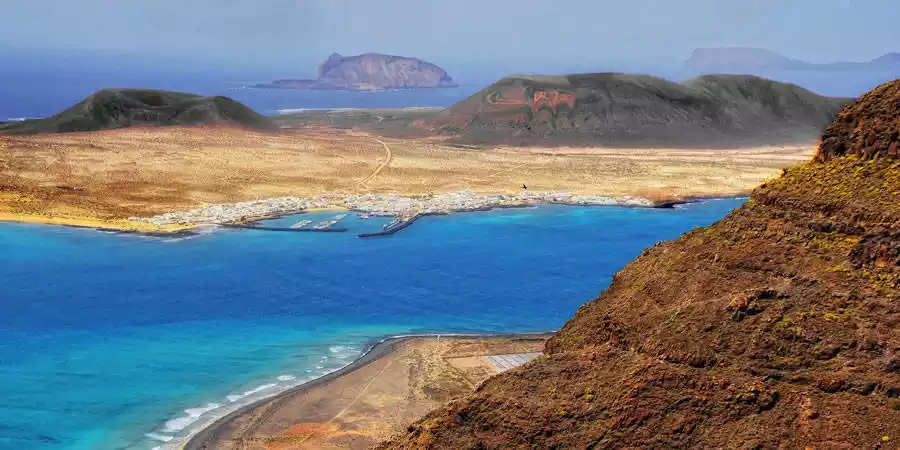
In 1986, the Natural Park of the Chinijo Archipelago was declared, becoming the first maritime-terrestrial natural park in Spain. It forms the largest marine reserve in Europe, covering 9,112 hectares. It includes the islets and rocks of the Chinijo Archipelago (La Graciosa, Alegranza, Montaña Clara, Roque del Este, and Roque del Oeste or Hell Rock), as well as the marine area surrounding them, the western coastal strip of the Famara massif, and the plains of Lomo Blanco and Costa Blanca. Additionally, the islet of Montaña Clara, along with Roque del Este and Roque del Oeste or Hell Rock, has special protection as an integral reserve.
Its geomorphological importance is significant, and we can distinguish two clearly differentiated zones:
The Famara Cliffs, which constitute an excellent example of the basaltic fissure emissions that formed the insular basement of Lanzarote, dating back between 5 and 10 million years. The islets of La Graciosa, Montaña Clara, and Alegranza, along with Roques del Este and del Oeste, form a well-preserved volcanic complex (originating during the Quaternary) supported by a submarine platform of less than 200 m depth that ends northwest of Alegranza.
In addition to its geological and landscape significance, it has biological importance as it houses the majority of the ecosystems present in Lanzarote, with several threatened and protected species—some exclusive to this park—and a nature in good conservation status. Moreover, the presence of prehistoric bird egg deposits in several locations adds additional scientific value.
The Natural Park is home to 120 species of lichens. There are also about 390 taxa of vascular flora, of which approximately 62 are endemic to the Canary Islands, representing 12% of the total for all of the Canary Islands, and 78.5% of the endemisms present in Lanzarote and its islets. Some notable species include Bupleurum handiense, Caralluma burchardii, Euphorbia balsamifera, etc.
The best-represented vegetation is the coastal salt marsh.
This area is of vital importance for the nesting of seabirds, raptors, and other very scarce birds. Additionally, it constitutes one of the most important sectors in the Canary Islands for migration, especially for migratory species. Therefore, it has been classified since 1994 as a Special Protection Area for Birds (SPA).
Numerous seabirds have their breeding colonies on the islets. Of these, seven species are nesting, such as the white-bellied storm-petrel and Madeira storm-petrel, the Cory's shearwater, and the lesser shearwater. Another group of birds present are raptors, represented by the ospreys, Eleanor's falcon, and the Egyptian vulture, among others.
Mammals are scarce, although one endemic species, the Canary shrew (Crocidura canariensis), is noted as the only native terrestrial mammal that breeds in this space. A few specimens that could belong to the Kuhl's pipistrelle (Pipistrellus kuhlii) have also been located, although their reproduction has not been confirmed.
Regarding reptiles, there are three endemic species from Fuerteventura, Lanzarote, and its islets: the Majorero or Rough gecko (Tarentola angustimentalis), the Atlantic lizard (Gallotia atlantica), and the Majorera skink (Chalcides simonyi).
As for terrestrial invertebrate species within the Natural Park of the Chinijo Archipelago, about 14 endemics can be found, such as Cryptella canariensis, a species of slug.
The marine environment of the islets maintains a unique richness due to its diversity of habitats and includes 228 species of fish. The rocky bottoms with seaweed meadows and sandy bottoms and seagrass beds host a great variety of fauna and flora, with pelagic species such as needlefish, amberjacks, and various species of tunas; and demersal species such as grouper, wrasses, parrotfish, sea breams, and sea robins, among others.
The waters of the archipelago are also rich in subtropical exotic species, both animal and plant, including: limpets, spiny starfish, lobsters, groupers, etc. Notable flora includes the alga Codium.
Some cetaceans can be observed in the park's waters, especially during migration months, such as: Balaenoptera acutorostrata, Grampus griseus, Delphinus delphis, etc.
There is also evidence of a few Mediterranean monk seals in the natural area, a species critically endangered.